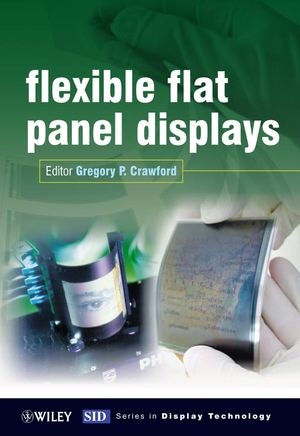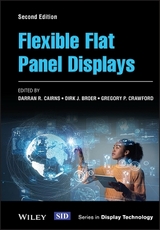
Flexible Flat Panel Displays
John Wiley & Sons Ltd (Verlag)
978-0-470-87048-8 (ISBN)
- Titel erscheint in neuer Auflage
- Artikel merken
Flexible displays are currently one of the most researched topics within the flat panel display community. They promise to change our display-centric world by replacing bulky rigid devices with those that are paper-thin and can be rolled away or folded up when not in use. The field of flexible flat panel displays is truly unique in the sense that it is interdisciplinary to the display community, combining basic principles from nearly all engineering and science disciplines. Organized to bring the reader from the component level, through display system and assembly, to the possible manufacturing routes Flexible Flat Panel Displays: outlines the underlying scientific theory required to develop flexible display applications; addresses the critical issues relating to the convergence of technologies including substrates, conducting layers, electro-optic materials and thin-film transistors; provides guidance on flexible display manufacturing; and presents market information and a chapter dedicated to future market trends of flexible flat panel displays.
Flexible Flat Panel Displays is an essential tool for scientists, engineers, designers and business and marketing professionals working at all levels of the display industry. Graduate students entering the field of display technology will also find this book an excellent reference.
Dr Crawford is head of the Display and Photonics Lab at Brown University. He has contributed chapters to numerous books (including Wiley's Encyclopaedia of Imaging Science & Technology) and published over 150 journal articles. He was recently elected chair of the 2005 and 2007 Gordon Conferences on Liquid Crystals.
List of Contributors. Foreword. Series Editor's Foreword. Preface. 1 Flexible Flat Panel Display Technology (Gregory P. Crawford). 1.1 Introduction. 1.2 Manufacturing. 1.3 Enabling Technologies. 1.4 Conclusions. References. 2 Engineered Films for Display Technologies (Bill A. MacDonald, Keith Rollins, Duncan MacKerron, Karl Rakos, Robert Eveson, and Bob Rustin). 2.1 Introduction. 2.2 Polymer Substrates. 2.3 Properties. 2.4 Polyester Films in Application. 2.5 Concluding Remarks. Acknowledgements. References. 3 Flexible Glass Substrates (Armin Plichta, Andreas Habeck, Silke Knoche, Norbert Hildebrand, Anke Kruse, and Andreas Weber). 3.1 Introduction. 3.2 Display Glass Properties. 3.3 Manufacturing of Thin "Flexible" Glass. 3.4 Mechanical Properties. 3.5 Improvement in Mechanical Properties of Glass. 3.6 Processing of Flexible Glass. 3.7 Current Thin Glass Substrate Applications and Trends. References. 4 Barrier Layer Technology for Flexible Displays (Gordon L. Graff, Paul E. Burrows, Rick E. Williford, and Robert F. Praino). 4.1 Introduction. 4.2 Development of Thin Film Vapor Barrier Systems. 4.3 Measurement Techniques. 4.4 Theories of Vapor Barrier Permeation. 4.5 Deconvolution of Experimental Data. 4.6 Discussion. 4.7 Conclusions. Acknowlegments. References. 5 Transparent Conducting Oxide Materials and Technology (David C. Paine, Hyo-Young Yeom and Burag Yaglioglu). 5.1 Introduction. 5.2 Materials Selection and Characterization. 5.3 Indium-Based Binary Oxides. 5.4 Future Directions for Transparent Conducting Oxides. 5.5 Summary. References. 6 Mechanics of ITO on Plastic Substrates for Flexible Displays (Piet C. P. Bouten, Peter J. Slikkerveer and Yves Leterrier). 6.1 Introduction. 6.2 Failure of Brittle Layers under Tensile Stress. 6.3 Failure of Brittle Layers under Compressive Stress. 6.4 The Failure Situation in a Display. 6.5 Conclusions. Acknowledgments. References. 7 Stability of Externally Deformed ITO Films (Jeong-In Han). 7.1 Introduction. 7.2 Mechanical Properties of Thin Films. 7.3 Conclusions. References. 8 Conductive Polymers (L. Bert Groenendaal). 8.1 Introduction. 8.2 Historical Overview. 8.3 Overview of Polymerization Methods. 8.4 Overview of Conductive Polymer Types. 8.5 Applications for Conductive Polymers. 8.6 Outlook. References. 9 Mechanical Reliability of Conductive Polymers for Rollable Display Applications (Darran R. Cairns). 9.1 Introduction. 9.2 Electromechanical Properties of Transparent Anodes. 9.2.1 ITO-coated PET in tension. 9.3 Environmental Degradation of PEDOT:PSS. 9.4 Cyclic Mandrel Loading of Flexible Anodes. 9.5 Conclusions. References. 10 Optical and Functional Coatings for Flexible Displays (Matthew Sousa and Gregory P. Crawford). 10.1 Introduction. 10.2 Thin Film Polarizers. 10.3 Thin Film Retarders. 10.4 Color Filters. 10.5 Alignment Layers. 10.6 Antireflective Coatings. 10.7 Summary. References. 11 Patterning Techniques and Semiconductor Materials for Flexible Electronics (John A. Rogers and Graciela Blanchet). 11.1 Introduction. 11.2 Large-Area Patterning Techniques. 11.3 Printable Semiconductors and Devices. 11.4 Prototype Circuits and Systems. 11.5 Conclusions. Acknowlegdements. References. 12 Printed Organic Electronics (Raj B. Apte, Robert A. Street, Ana Claudia Arias, Alberto Salleo, Michael Chabinyc, William S. Wong, Beng S. Ong Yiliang Wu, Ping Liu, and Sandra Gardner). 12.1 Introduction. 12.2 System Requirements. 12.3 Transistor Requirements. 12.4 Organic Semiconductors. 12.5 Digital Lithography. 12.6 Prospects. Acknowledgments. References. 13 Rollable Active Matrix Displays with Organic Electronics (Edzer Huitema, Gerwin Gelinck, Erik van Veenendaal, Fred Touwslager, and Pieter van Lieshout). 13.1 Introduction. 13.2 Flexible Display Overview. 13.3 Organic Electronics Technology. 13.4 Display Design and Processing. 13.5 Transistor Requirements. 13.6 Transistor Characteristics. 13.7 Functional Displays. 13.8 Driver Integration. Acknowledgment. References. 14 Awaiting Author Copy (Sigard Wagner). 15 OLED Displays on Plastic (Mark L. Hildner). 15.1 Introduction. 15.2 PLED Basics. 15.3 Plastic Substrates for OLED. 15.4 Substrate Processing Issues. 15.5 Passive Matrix Display Fabrication. 15.6 Active Matrix for OLED on Plastic. 15.7 Conclusion. Acknowledgments. References. 16 Encapsulated Liquid Crystal Materials for Flexible Display Applications (Gregory P. Crawford). 16.1 Introduction. 16.2 History of Encapsulated Liquid Crystals. 16.3 Encapsulation Techniques. 16.4 Conformed Polymer-Dispersed Liquid Crystals. 16.5 Holographic Polymer-Dispersed Liquid Crystals. 16.6 Prefabricated Templates Impregnated with Liquid Crystal. 16.7 Summary. References. 17 Cholesteric Liquid Crystals for Flexible Displays (J. William Doane and Asad Khan). 17.1 Introduction. 17.2 Basic Properties of Cholesteric Displays. 17.3 Drive Schemes, Chips and Circuitry. 17.4 Power Consumption. 17.5 Full Color. 17.6 Droplet Dispersions for Flexible Displays. 17.7 Toward Flexible Displays. 17.8 Conclusions. References. 18 Paintable LCDs: Single-Substrate LCDs Produced by Photoenforced Stratification (Roel Penterman, Stephen I. Klink, Joost Vogels, Edzer Huitema, Henk de Koning, and Dirk Broer). 18.1 Introduction. 18.2 Photoenforced Stratification. 18.3 Experimental Procedures. 18.4 Single UV exposure. 18.5 Two-step UV exposure. 18.6 Paintable Displays. 18.7 Improved Paintable LCD Technology. 18.8 Conclusion. Acknowledgments. References. 19 Electrophoretic Imaging Films for Electronic Paper Displays (Karl Amundson). 19.1 Introduction. 19.2 Scattering Imaging Films for Displays. 19.3 Electrophoresis and Electrophoretic Imaging. 19.4 Current Electrophoretic Display Development Efforts. 19.5 Flexible and Conformable EPID Displays. References. 20 Gyricon Materials for Flexible Displays (Nicolas Sheridon). 20.1 Introduction. 20.2 Electro-optical Response. 20.3 Image Storage. 20.4 Brightness and Contrast. 20.5 Addressing Methods. 20.6 Fabrication. 20.7 Conclusions. References. 21 Roll-to-Roll Manufacturing of Flexible Displays (Abbie Gregg, Lara York, and Mark Strnad). 21.1 Background. 21.2 Objective. 21.3 Device Scenario 21.4 Product Design. 21.5 Tools. 21.6 Device Inspection. 21.6.1 Darkfield technologies. 21.6.2 Batch web coater for EB deposition. 21.7 Die Punch for Alignment and Registration. 21.8 Evaporator: Thermal Cathode for LEP device. 21.9 Evaporator: OLED. 21.10 Exposure: Proximity. 21.11 Exposure: Step and Repeat. 21.12 Inkjet Deposition. 21.12.1 Litrex 140L inkjet system. 21.13 Lamination. 21.14 Laser Processing. 21.15 Roll Coater: Photoresist. 21.16 Screen Printer. 21.17 Oven for Low-Temperature Curing. 21.18 Sputtering. 21.19 Materials Discussion . 21.20 Thermal Budget for Plastic Substrates. 21.21 Interleaf or Slip Sheet. 21.22 Materials List. 21.23 Processing Issues. 21.24 Material Handling in Roll-to-Roll Processing. 21.25 Results from the Cost Model. Bibliography. 22 High-Resolution Full-Color Flexible TFT LCDs Based on Amorphous Silicon (Jin Jang, Sung Hwan Won, Bo Sung Kim, Mun Pyo Hong, and Kyu Ha Chung). 22.1 Introduction. 22.2 Effect of He Dilution on SiNx Deposition. 22.3 a-Si:H TFT on Plastic with an Organic Gate Insulator. 22.4 Fabrication of an a-Si:H TFT Array on Plastic. 22.5 a-Si:H TFT LCD on Plastic. References. 23 All-Plastic Color TFT LCDs Based on Low-Temperature Poly-Si (Akihiko Asano). 23.1 Introduction. 23.2 Overview of the Process. 23.3 Results of the Transfer Process. 23.4 Changes in TFT Characteristics with Substrate Bending. 23.5 Display Properties of Plastic LCDs. 23.6 Problems to Solve. 23.7 Summaries and Future Prospect. Acknowledgments. References. 24 TFT Transfer Technology (Sumio Utsunomiya, Satoshi Inoue, and Tatsuya Shimoda). 24.1 Introduction. 24.2 TFT Transfer Process Sequence. 24.3 Transfer Mechanism. 24.4 TFT Performance. 24.5 Applications. 24.6 Summary. References. 25 Markets and Applications of Flexible Displays (Kimberly Allen). 25.1 Introduction. 25.2 Why Flexible? 25.3 Supporting Technologies. 25.4 Flexible Display Technologies. 25.5 Market Forecast. 25.6 Regional Development. 25.7 Investment And Commitment . 25.8 What Will It Take? 25.9 Conclusion. References. Index.
| Erscheint lt. Verlag | 25.4.2005 |
|---|---|
| Reihe/Serie | Wiley Series in Display Technology |
| Verlagsort | Chichester |
| Sprache | englisch |
| Maße | 177 x 252 mm |
| Gewicht | 1042 g |
| Themenwelt | Naturwissenschaften ► Chemie |
| Technik ► Elektrotechnik / Energietechnik | |
| ISBN-10 | 0-470-87048-6 / 0470870486 |
| ISBN-13 | 978-0-470-87048-8 / 9780470870488 |
| Zustand | Neuware |
| Informationen gemäß Produktsicherheitsverordnung (GPSR) | |
| Haben Sie eine Frage zum Produkt? |
aus dem Bereich



